HR Development Report: Training Needs, Evaluation, and Government Role
VerifiedAdded on 2020/01/23
|19
|4288
|193
Report
AI Summary
This report delves into the multifaceted aspects of human resource development (HRD), encompassing training needs across various organizational levels, advantages and disadvantages of training methods, and a systematic approach to planning training and development programs. It further explores evaluation techniques used to assess training effectiveness, including observation, controlled experiments, and feedback mechanisms. The report also examines the role of government in promoting training, development, and lifelong learning, alongside the development of the competency movement and contemporary training initiatives in the UK. The report provides a comprehensive analysis of training programs, documentation processes, and productivity variations, with a focus on improving employee skills and organizational goals.

Human Resource Development
Felicia Loredana Andrei
ID 12212
Table of Contents
1 | P a g e
Felicia Loredana Andrei
ID 12212
Table of Contents
1 | P a g e
Paraphrase This Document
Need a fresh take? Get an instant paraphrase of this document with our AI Paraphraser
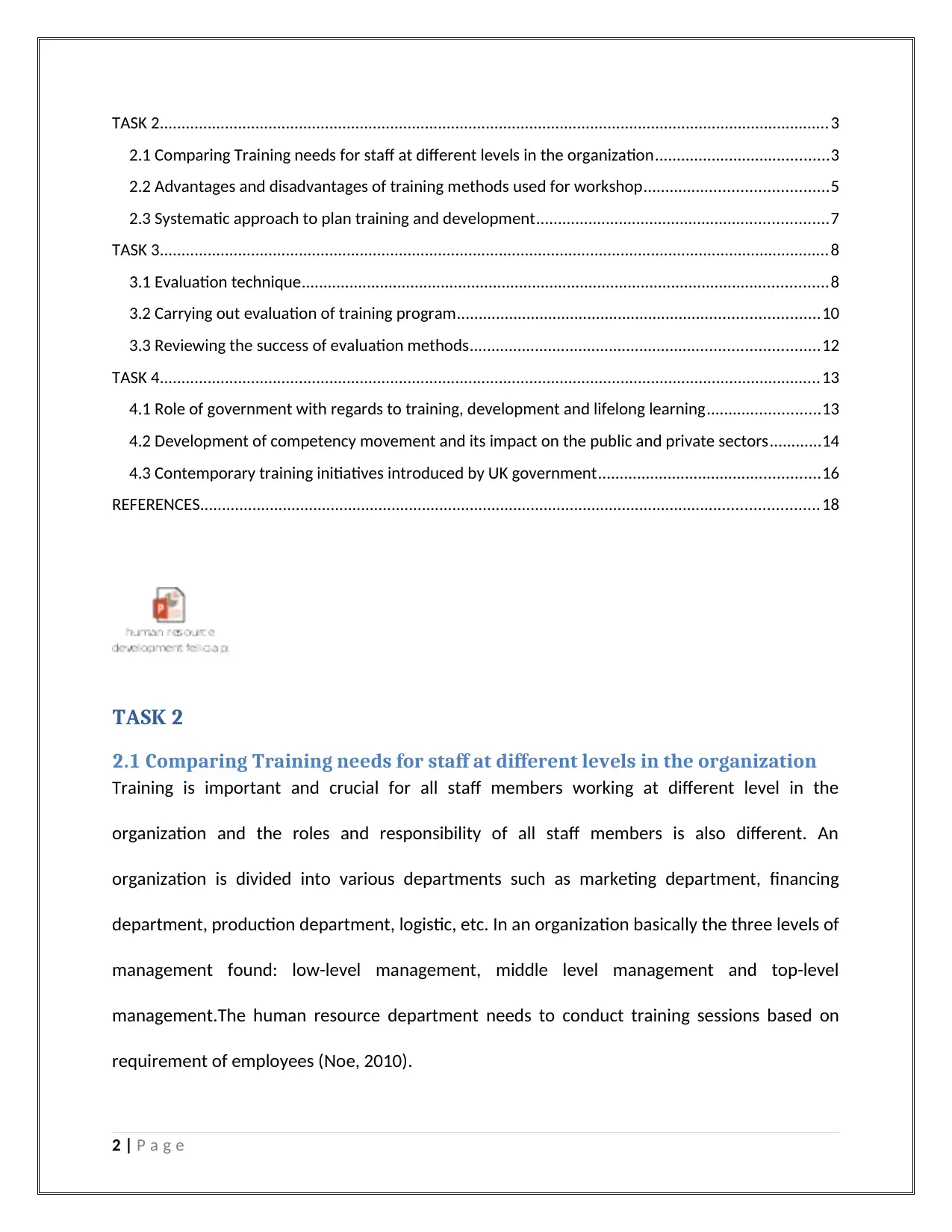
TASK 2..........................................................................................................................................................3
2.1 Comparing Training needs for staff at different levels in the organization........................................3
2.2 Advantages and disadvantages of training methods used for workshop..........................................5
2.3 Systematic approach to plan training and development...................................................................7
TASK 3..........................................................................................................................................................8
3.1 Evaluation technique.........................................................................................................................8
3.2 Carrying out evaluation of training program...................................................................................10
3.3 Reviewing the success of evaluation methods................................................................................12
TASK 4........................................................................................................................................................13
4.1 Role of government with regards to training, development and lifelong learning..........................13
4.2 Development of competency movement and its impact on the public and private sectors............14
4.3 Contemporary training initiatives introduced by UK government...................................................16
REFERENCES..............................................................................................................................................18
TASK 2
2.1 Comparing Training needs for staff at different levels in the organization
Training is important and crucial for all staff members working at different level in the
organization and the roles and responsibility of all staff members is also different. An
organization is divided into various departments such as marketing department, financing
department, production department, logistic, etc. In an organization basically the three levels of
management found: low-level management, middle level management and top-level
management.The human resource department needs to conduct training sessions based on
requirement of employees (Noe, 2010).
2 | P a g e
2.1 Comparing Training needs for staff at different levels in the organization........................................3
2.2 Advantages and disadvantages of training methods used for workshop..........................................5
2.3 Systematic approach to plan training and development...................................................................7
TASK 3..........................................................................................................................................................8
3.1 Evaluation technique.........................................................................................................................8
3.2 Carrying out evaluation of training program...................................................................................10
3.3 Reviewing the success of evaluation methods................................................................................12
TASK 4........................................................................................................................................................13
4.1 Role of government with regards to training, development and lifelong learning..........................13
4.2 Development of competency movement and its impact on the public and private sectors............14
4.3 Contemporary training initiatives introduced by UK government...................................................16
REFERENCES..............................................................................................................................................18
TASK 2
2.1 Comparing Training needs for staff at different levels in the organization
Training is important and crucial for all staff members working at different level in the
organization and the roles and responsibility of all staff members is also different. An
organization is divided into various departments such as marketing department, financing
department, production department, logistic, etc. In an organization basically the three levels of
management found: low-level management, middle level management and top-level
management.The human resource department needs to conduct training sessions based on
requirement of employees (Noe, 2010).
2 | P a g e
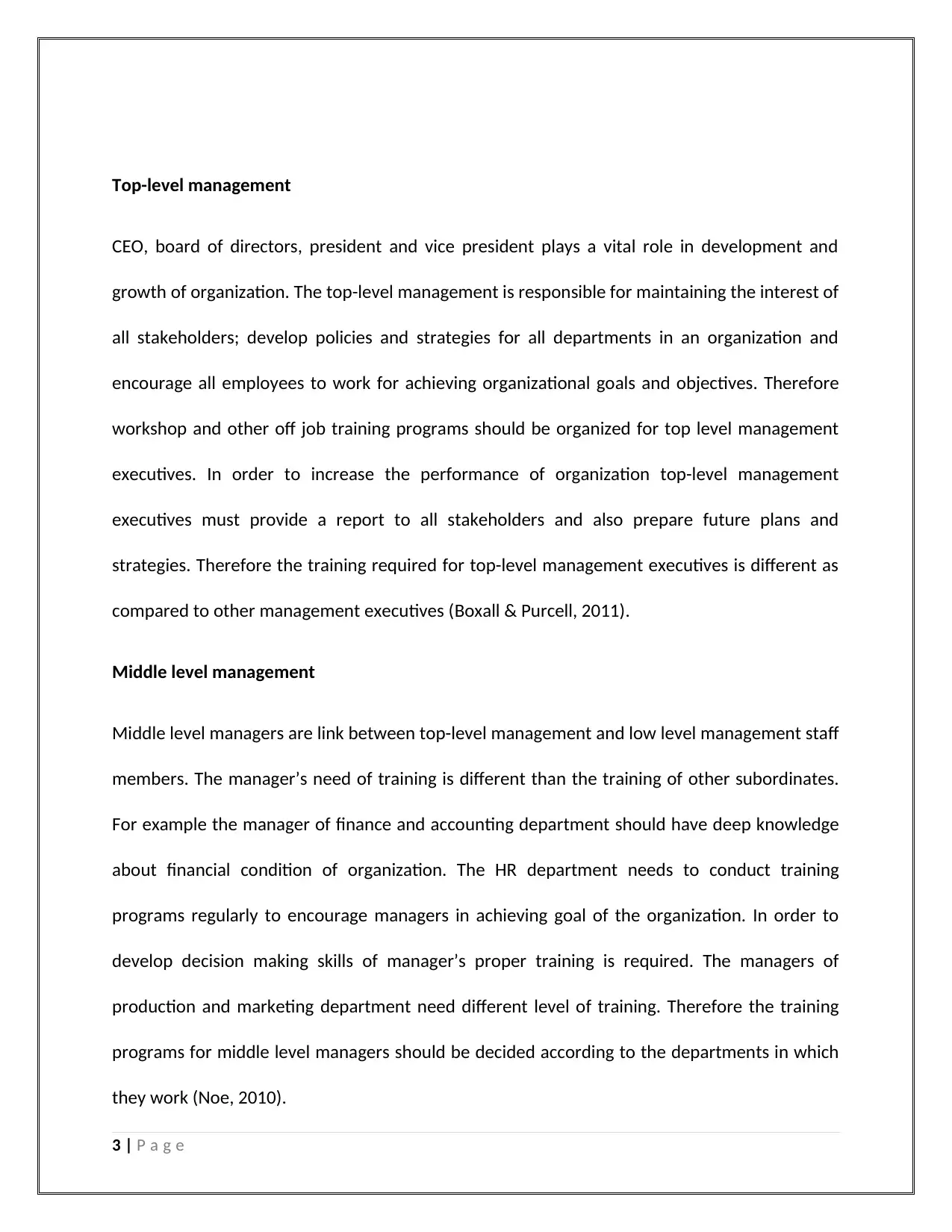
Top-level management
CEO, board of directors, president and vice president plays a vital role in development and
growth of organization. The top-level management is responsible for maintaining the interest of
all stakeholders; develop policies and strategies for all departments in an organization and
encourage all employees to work for achieving organizational goals and objectives. Therefore
workshop and other off job training programs should be organized for top level management
executives. In order to increase the performance of organization top-level management
executives must provide a report to all stakeholders and also prepare future plans and
strategies. Therefore the training required for top-level management executives is different as
compared to other management executives (Boxall & Purcell, 2011).
Middle level management
Middle level managers are link between top-level management and low level management staff
members. The manager’s need of training is different than the training of other subordinates.
For example the manager of finance and accounting department should have deep knowledge
about financial condition of organization. The HR department needs to conduct training
programs regularly to encourage managers in achieving goal of the organization. In order to
develop decision making skills of manager’s proper training is required. The managers of
production and marketing department need different level of training. Therefore the training
programs for middle level managers should be decided according to the departments in which
they work (Noe, 2010).
3 | P a g e
CEO, board of directors, president and vice president plays a vital role in development and
growth of organization. The top-level management is responsible for maintaining the interest of
all stakeholders; develop policies and strategies for all departments in an organization and
encourage all employees to work for achieving organizational goals and objectives. Therefore
workshop and other off job training programs should be organized for top level management
executives. In order to increase the performance of organization top-level management
executives must provide a report to all stakeholders and also prepare future plans and
strategies. Therefore the training required for top-level management executives is different as
compared to other management executives (Boxall & Purcell, 2011).
Middle level management
Middle level managers are link between top-level management and low level management staff
members. The manager’s need of training is different than the training of other subordinates.
For example the manager of finance and accounting department should have deep knowledge
about financial condition of organization. The HR department needs to conduct training
programs regularly to encourage managers in achieving goal of the organization. In order to
develop decision making skills of manager’s proper training is required. The managers of
production and marketing department need different level of training. Therefore the training
programs for middle level managers should be decided according to the departments in which
they work (Noe, 2010).
3 | P a g e
⊘ This is a preview!⊘
Do you want full access?
Subscribe today to unlock all pages.

Trusted by 1+ million students worldwide

Low level management
Low level staff members are responsible for all operational work in an organization. Supervisors
give orders to employees and instruct them work procedures. Supervisors inform middle level
managers about the problems of workers and also provide on job training to workers, maintain
discipline among workers solve problems of workers. Therefore the training for low level
management staff is very necessary because they handle operational activities of company and
they are image builders of organization. Hence the level of training of different for all staff
members working in company and HR managers need to conduct training session for particular
department (Grohmann & Kauffeld, 2013).
2.2 Advantages and disadvantages of training methods used for workshop
The training methods that will be used for workshop include:
1. The lecture method – It is the traditional and direct method of instruction where an
instructor gives verbal presentation to large audience. The lecture method must
motivate and create interest among trainees. This is one of the most efficient training
methods because in relatively short time many ideas or strategies can be informed to
employees (Lee, 2010).
Advantages
For instructing large groups at a particular time lecture would be convenient
method
Time required for preparation is less as compared to other training methods
4 | P a g e
Low level staff members are responsible for all operational work in an organization. Supervisors
give orders to employees and instruct them work procedures. Supervisors inform middle level
managers about the problems of workers and also provide on job training to workers, maintain
discipline among workers solve problems of workers. Therefore the training for low level
management staff is very necessary because they handle operational activities of company and
they are image builders of organization. Hence the level of training of different for all staff
members working in company and HR managers need to conduct training session for particular
department (Grohmann & Kauffeld, 2013).
2.2 Advantages and disadvantages of training methods used for workshop
The training methods that will be used for workshop include:
1. The lecture method – It is the traditional and direct method of instruction where an
instructor gives verbal presentation to large audience. The lecture method must
motivate and create interest among trainees. This is one of the most efficient training
methods because in relatively short time many ideas or strategies can be informed to
employees (Lee, 2010).
Advantages
For instructing large groups at a particular time lecture would be convenient
method
Time required for preparation is less as compared to other training methods
4 | P a g e
Paraphrase This Document
Need a fresh take? Get an instant paraphrase of this document with our AI Paraphraser

Effective method as it provide lots of information quickly
Cost required for conducting lectures is also low
Disadvantages
As lectures are presented in oral form therefore trainees may forget useful
information
Trainees may pay less attention if material used for lecture is not informative
(Noe, 2010)
2. Computer based training – It is also known as computer assisted instruction or
computer assisted learning. In this type of training instructions deliver with a computer
instead of human instructor, for example via internet.
Advantages
It is cost effective training, initially developing a computer based training
centre would be expensive but after setup training would be given to
employees at any time
Trainees may feel more comfortable in doing exercises online
It give relaxation to human trainers and managers because all activities are
programed in computer
Disadvantages
5 | P a g e
Cost required for conducting lectures is also low
Disadvantages
As lectures are presented in oral form therefore trainees may forget useful
information
Trainees may pay less attention if material used for lecture is not informative
(Noe, 2010)
2. Computer based training – It is also known as computer assisted instruction or
computer assisted learning. In this type of training instructions deliver with a computer
instead of human instructor, for example via internet.
Advantages
It is cost effective training, initially developing a computer based training
centre would be expensive but after setup training would be given to
employees at any time
Trainees may feel more comfortable in doing exercises online
It give relaxation to human trainers and managers because all activities are
programed in computer
Disadvantages
5 | P a g e
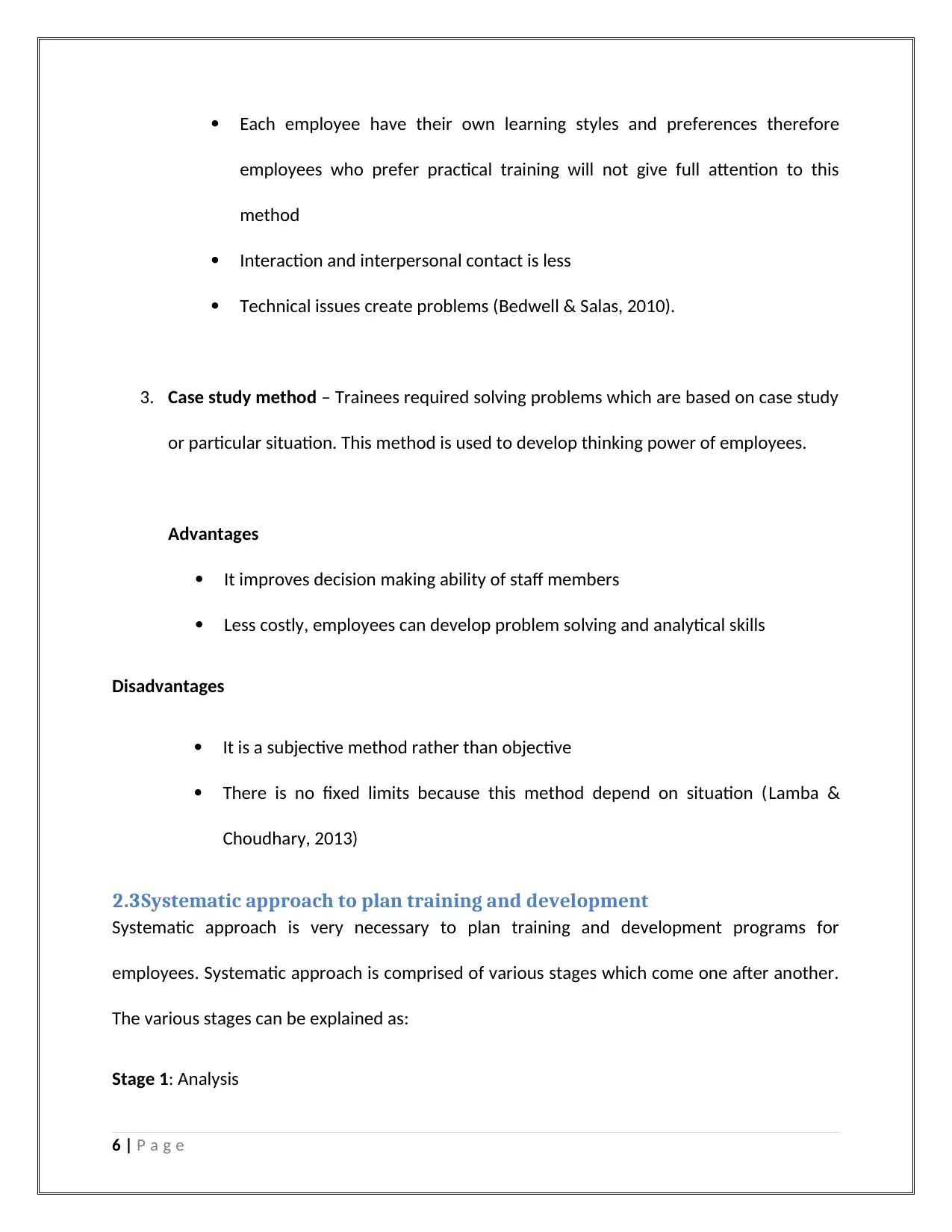
Each employee have their own learning styles and preferences therefore
employees who prefer practical training will not give full attention to this
method
Interaction and interpersonal contact is less
Technical issues create problems (Bedwell & Salas, 2010).
3. Case study method – Trainees required solving problems which are based on case study
or particular situation. This method is used to develop thinking power of employees.
Advantages
It improves decision making ability of staff members
Less costly, employees can develop problem solving and analytical skills
Disadvantages
It is a subjective method rather than objective
There is no fixed limits because this method depend on situation (Lamba &
Choudhary, 2013)
2.3Systematic approach to plan training and development
Systematic approach is very necessary to plan training and development programs for
employees. Systematic approach is comprised of various stages which come one after another.
The various stages can be explained as:
Stage 1: Analysis
6 | P a g e
employees who prefer practical training will not give full attention to this
method
Interaction and interpersonal contact is less
Technical issues create problems (Bedwell & Salas, 2010).
3. Case study method – Trainees required solving problems which are based on case study
or particular situation. This method is used to develop thinking power of employees.
Advantages
It improves decision making ability of staff members
Less costly, employees can develop problem solving and analytical skills
Disadvantages
It is a subjective method rather than objective
There is no fixed limits because this method depend on situation (Lamba &
Choudhary, 2013)
2.3Systematic approach to plan training and development
Systematic approach is very necessary to plan training and development programs for
employees. Systematic approach is comprised of various stages which come one after another.
The various stages can be explained as:
Stage 1: Analysis
6 | P a g e
⊘ This is a preview!⊘
Do you want full access?
Subscribe today to unlock all pages.

Trusted by 1+ million students worldwide
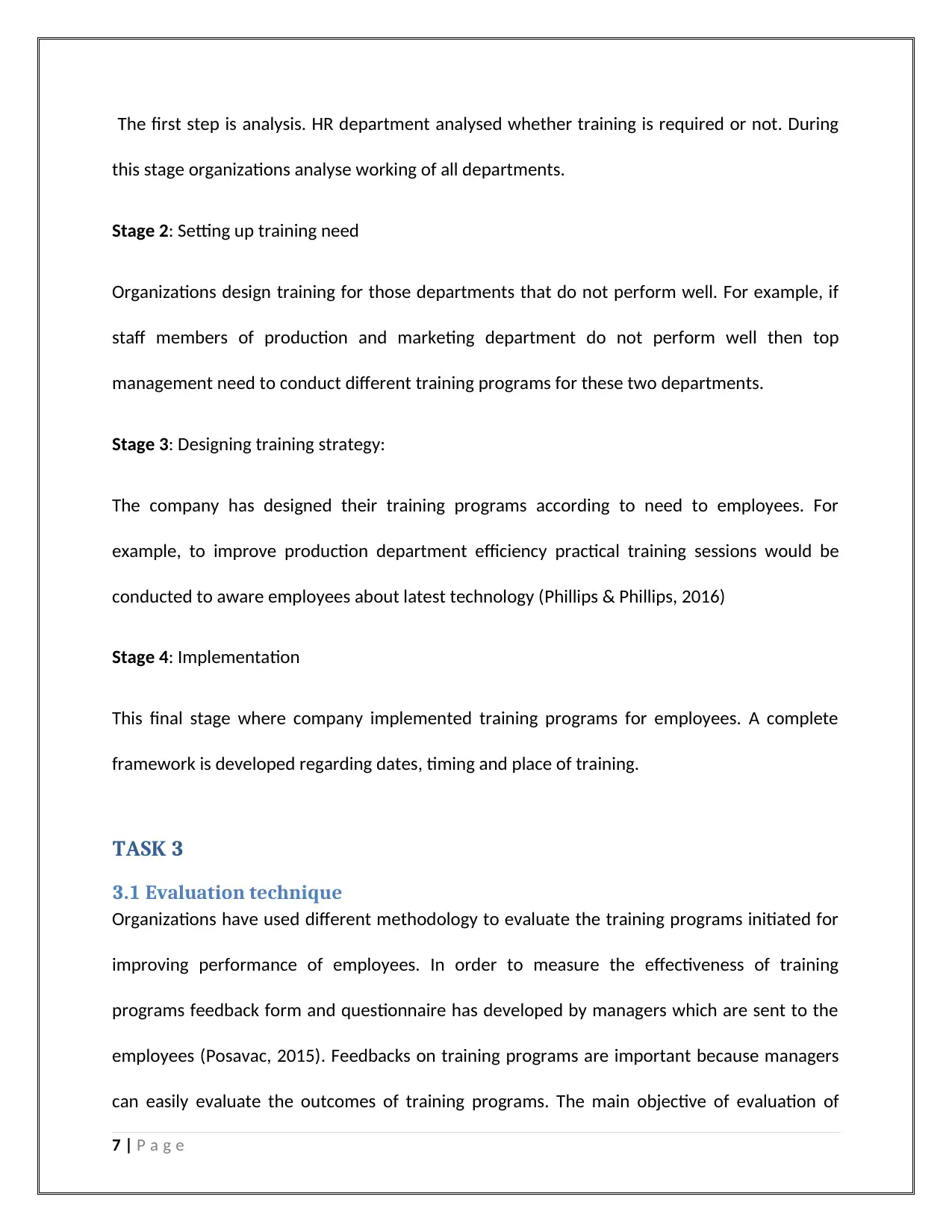
The first step is analysis. HR department analysed whether training is required or not. During
this stage organizations analyse working of all departments.
Stage 2: Setting up training need
Organizations design training for those departments that do not perform well. For example, if
staff members of production and marketing department do not perform well then top
management need to conduct different training programs for these two departments.
Stage 3: Designing training strategy:
The company has designed their training programs according to need to employees. For
example, to improve production department efficiency practical training sessions would be
conducted to aware employees about latest technology (Phillips & Phillips, 2016)
Stage 4: Implementation
This final stage where company implemented training programs for employees. A complete
framework is developed regarding dates, timing and place of training.
TASK 3
3.1 Evaluation technique
Organizations have used different methodology to evaluate the training programs initiated for
improving performance of employees. In order to measure the effectiveness of training
programs feedback form and questionnaire has developed by managers which are sent to the
employees (Posavac, 2015). Feedbacks on training programs are important because managers
can easily evaluate the outcomes of training programs. The main objective of evaluation of
7 | P a g e
this stage organizations analyse working of all departments.
Stage 2: Setting up training need
Organizations design training for those departments that do not perform well. For example, if
staff members of production and marketing department do not perform well then top
management need to conduct different training programs for these two departments.
Stage 3: Designing training strategy:
The company has designed their training programs according to need to employees. For
example, to improve production department efficiency practical training sessions would be
conducted to aware employees about latest technology (Phillips & Phillips, 2016)
Stage 4: Implementation
This final stage where company implemented training programs for employees. A complete
framework is developed regarding dates, timing and place of training.
TASK 3
3.1 Evaluation technique
Organizations have used different methodology to evaluate the training programs initiated for
improving performance of employees. In order to measure the effectiveness of training
programs feedback form and questionnaire has developed by managers which are sent to the
employees (Posavac, 2015). Feedbacks on training programs are important because managers
can easily evaluate the outcomes of training programs. The main objective of evaluation of
7 | P a g e
Paraphrase This Document
Need a fresh take? Get an instant paraphrase of this document with our AI Paraphraser

training programs is to find whether performance of employees improved or not and whether
they get enough knowledge or not. For example, training programs conducted for production
department of any company would be effective when efficiency of employees and productivity
will increase. Human resource managers observed whole training program and assess
performance of employees for near 3 to 4 weeks. The evaluation can be done through 4 stages:
1. Observation- Before conducting the process o evaluation it is important to search out
the needs of evaluation. In order to find out the requirements the essential prices suit to
observe or monitor the present situation and work ability of the employees. By
monitoring in the right way the human resources can get the information about the
requirements. It is the duty of the HR to build the proper report of the present
conditions of the employees.
2. Improvement areas– It is very important to notice the changes that took place after
conducting training programs for different departments in organization. In order to
evaluate the progress of the work the HR need to search out ten exact areas in which
the evaluation is important. With the proper ideas about the appropriate places of
evaluation the HR of the organisation can conduct the evaluation process. The proper
strategies and techniques of evaluation can improve the work policies of the
organisation.
3. Controlled experiments – Human resource managers also evaluate effectiveness of
training programs, they whether events helps in improving skills and learning of
employees. The HR managers of the organisation need to done some experiments of the
evaluation process before conducting the final evaluation. By applying the strategies
8 | P a g e
they get enough knowledge or not. For example, training programs conducted for production
department of any company would be effective when efficiency of employees and productivity
will increase. Human resource managers observed whole training program and assess
performance of employees for near 3 to 4 weeks. The evaluation can be done through 4 stages:
1. Observation- Before conducting the process o evaluation it is important to search out
the needs of evaluation. In order to find out the requirements the essential prices suit to
observe or monitor the present situation and work ability of the employees. By
monitoring in the right way the human resources can get the information about the
requirements. It is the duty of the HR to build the proper report of the present
conditions of the employees.
2. Improvement areas– It is very important to notice the changes that took place after
conducting training programs for different departments in organization. In order to
evaluate the progress of the work the HR need to search out ten exact areas in which
the evaluation is important. With the proper ideas about the appropriate places of
evaluation the HR of the organisation can conduct the evaluation process. The proper
strategies and techniques of evaluation can improve the work policies of the
organisation.
3. Controlled experiments – Human resource managers also evaluate effectiveness of
training programs, they whether events helps in improving skills and learning of
employees. The HR managers of the organisation need to done some experiments of the
evaluation process before conducting the final evaluation. By applying the strategies
8 | P a g e
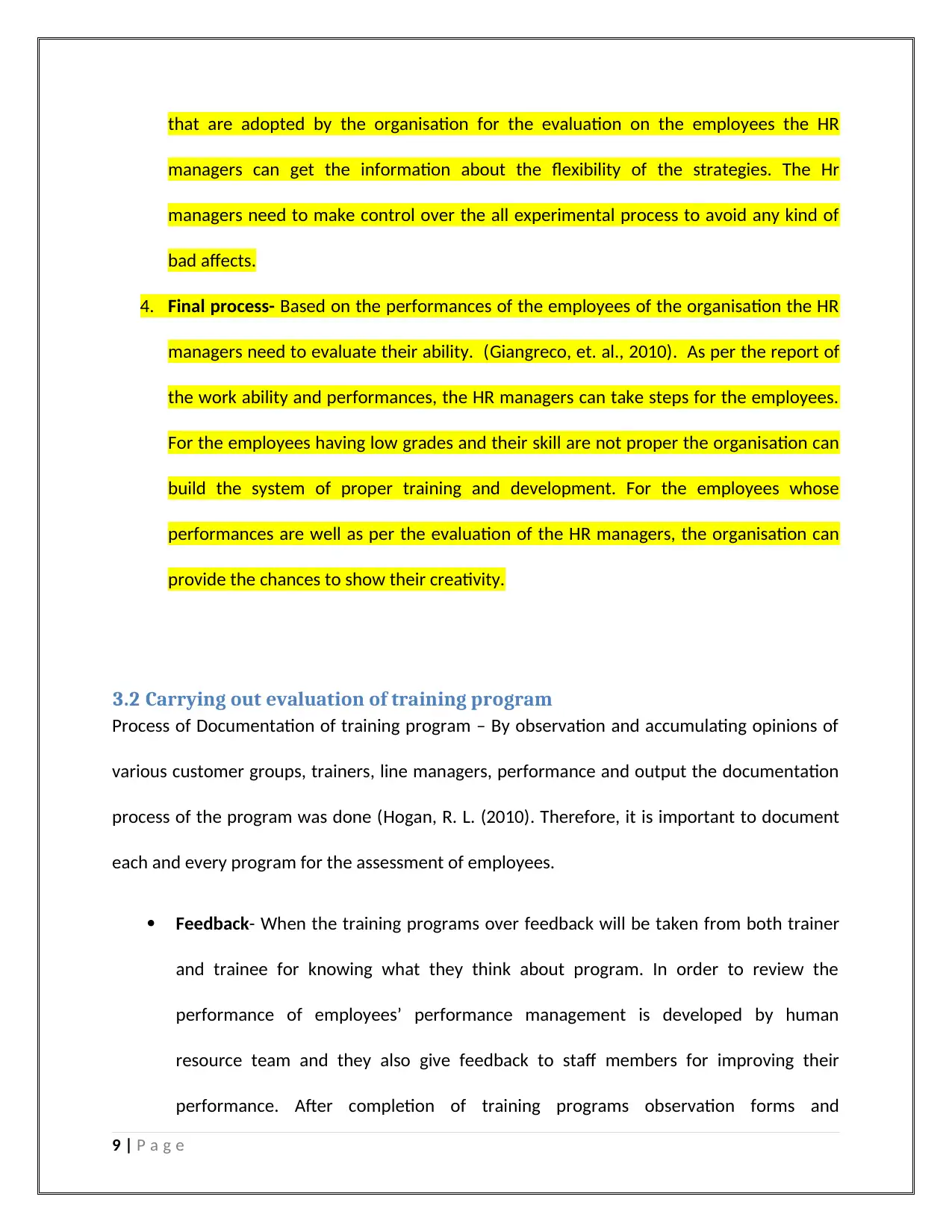
that are adopted by the organisation for the evaluation on the employees the HR
managers can get the information about the flexibility of the strategies. The Hr
managers need to make control over the all experimental process to avoid any kind of
bad affects.
4. Final process- Based on the performances of the employees of the organisation the HR
managers need to evaluate their ability. (Giangreco, et. al., 2010). As per the report of
the work ability and performances, the HR managers can take steps for the employees.
For the employees having low grades and their skill are not proper the organisation can
build the system of proper training and development. For the employees whose
performances are well as per the evaluation of the HR managers, the organisation can
provide the chances to show their creativity.
3.2 Carrying out evaluation of training program
Process of Documentation of training program – By observation and accumulating opinions of
various customer groups, trainers, line managers, performance and output the documentation
process of the program was done (Hogan, R. L. (2010). Therefore, it is important to document
each and every program for the assessment of employees.
Feedback- When the training programs over feedback will be taken from both trainer
and trainee for knowing what they think about program. In order to review the
performance of employees’ performance management is developed by human
resource team and they also give feedback to staff members for improving their
performance. After completion of training programs observation forms and
9 | P a g e
managers can get the information about the flexibility of the strategies. The Hr
managers need to make control over the all experimental process to avoid any kind of
bad affects.
4. Final process- Based on the performances of the employees of the organisation the HR
managers need to evaluate their ability. (Giangreco, et. al., 2010). As per the report of
the work ability and performances, the HR managers can take steps for the employees.
For the employees having low grades and their skill are not proper the organisation can
build the system of proper training and development. For the employees whose
performances are well as per the evaluation of the HR managers, the organisation can
provide the chances to show their creativity.
3.2 Carrying out evaluation of training program
Process of Documentation of training program – By observation and accumulating opinions of
various customer groups, trainers, line managers, performance and output the documentation
process of the program was done (Hogan, R. L. (2010). Therefore, it is important to document
each and every program for the assessment of employees.
Feedback- When the training programs over feedback will be taken from both trainer
and trainee for knowing what they think about program. In order to review the
performance of employees’ performance management is developed by human
resource team and they also give feedback to staff members for improving their
performance. After completion of training programs observation forms and
9 | P a g e
⊘ This is a preview!⊘
Do you want full access?
Subscribe today to unlock all pages.

Trusted by 1+ million students worldwide
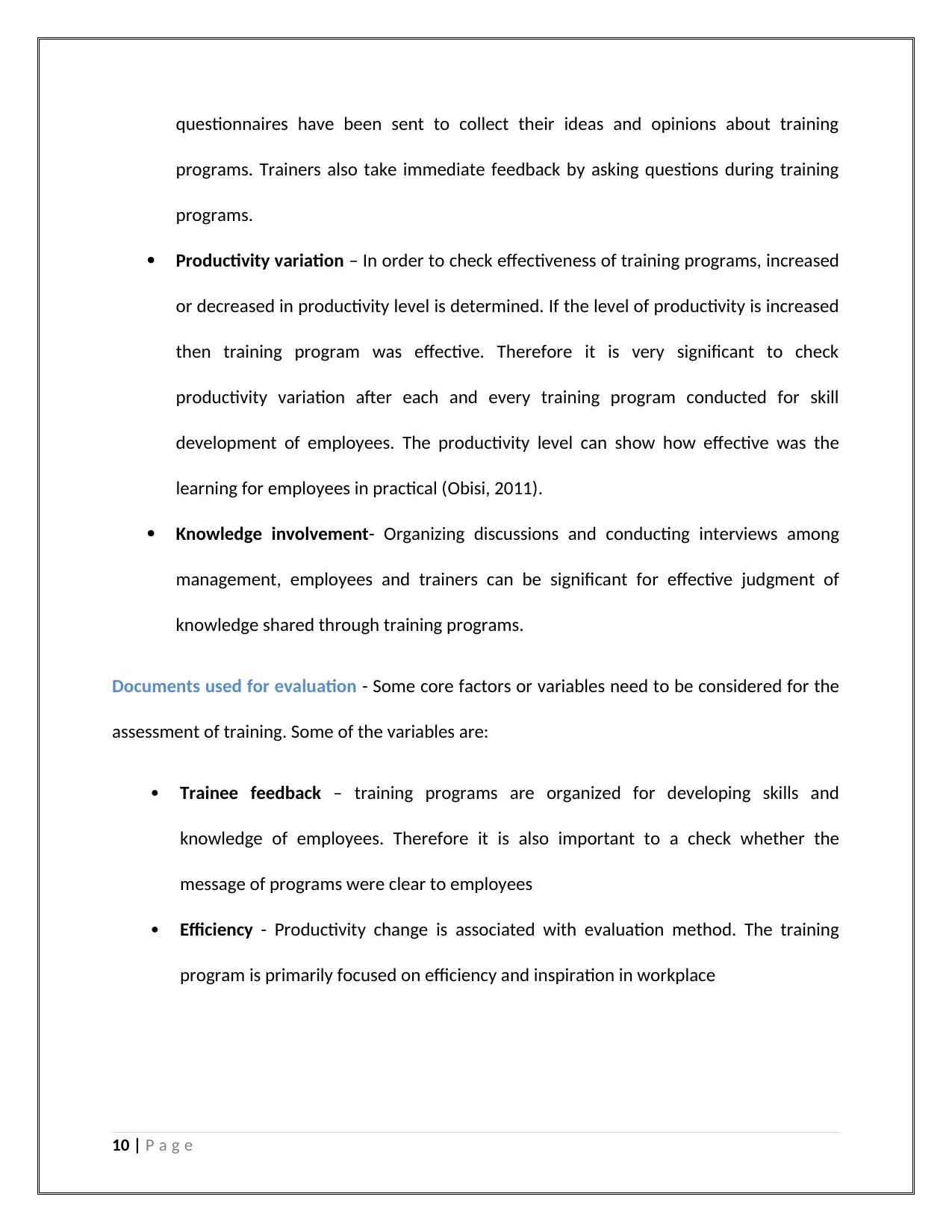
questionnaires have been sent to collect their ideas and opinions about training
programs. Trainers also take immediate feedback by asking questions during training
programs.
Productivity variation – In order to check effectiveness of training programs, increased
or decreased in productivity level is determined. If the level of productivity is increased
then training program was effective. Therefore it is very significant to check
productivity variation after each and every training program conducted for skill
development of employees. The productivity level can show how effective was the
learning for employees in practical (Obisi, 2011).
Knowledge involvement- Organizing discussions and conducting interviews among
management, employees and trainers can be significant for effective judgment of
knowledge shared through training programs.
Documents used for evaluation - Some core factors or variables need to be considered for the
assessment of training. Some of the variables are:
Trainee feedback – training programs are organized for developing skills and
knowledge of employees. Therefore it is also important to a check whether the
message of programs were clear to employees
Efficiency - Productivity change is associated with evaluation method. The training
program is primarily focused on efficiency and inspiration in workplace
10 | P a g e
programs. Trainers also take immediate feedback by asking questions during training
programs.
Productivity variation – In order to check effectiveness of training programs, increased
or decreased in productivity level is determined. If the level of productivity is increased
then training program was effective. Therefore it is very significant to check
productivity variation after each and every training program conducted for skill
development of employees. The productivity level can show how effective was the
learning for employees in practical (Obisi, 2011).
Knowledge involvement- Organizing discussions and conducting interviews among
management, employees and trainers can be significant for effective judgment of
knowledge shared through training programs.
Documents used for evaluation - Some core factors or variables need to be considered for the
assessment of training. Some of the variables are:
Trainee feedback – training programs are organized for developing skills and
knowledge of employees. Therefore it is also important to a check whether the
message of programs were clear to employees
Efficiency - Productivity change is associated with evaluation method. The training
program is primarily focused on efficiency and inspiration in workplace
10 | P a g e
Paraphrase This Document
Need a fresh take? Get an instant paraphrase of this document with our AI Paraphraser
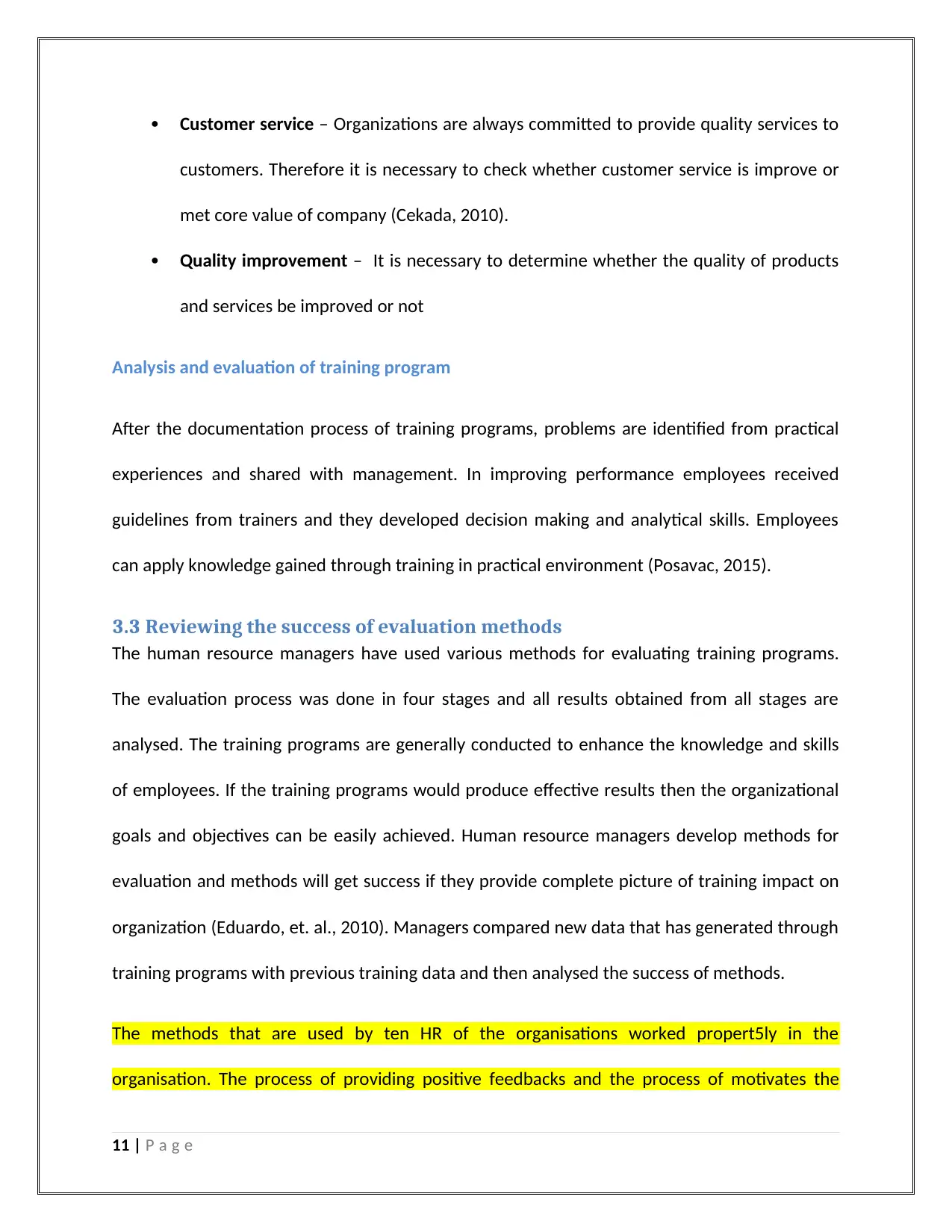
Customer service – Organizations are always committed to provide quality services to
customers. Therefore it is necessary to check whether customer service is improve or
met core value of company (Cekada, 2010).
Quality improvement – It is necessary to determine whether the quality of products
and services be improved or not
Analysis and evaluation of training program
After the documentation process of training programs, problems are identified from practical
experiences and shared with management. In improving performance employees received
guidelines from trainers and they developed decision making and analytical skills. Employees
can apply knowledge gained through training in practical environment (Posavac, 2015).
3.3 Reviewing the success of evaluation methods
The human resource managers have used various methods for evaluating training programs.
The evaluation process was done in four stages and all results obtained from all stages are
analysed. The training programs are generally conducted to enhance the knowledge and skills
of employees. If the training programs would produce effective results then the organizational
goals and objectives can be easily achieved. Human resource managers develop methods for
evaluation and methods will get success if they provide complete picture of training impact on
organization (Eduardo, et. al., 2010). Managers compared new data that has generated through
training programs with previous training data and then analysed the success of methods.
The methods that are used by ten HR of the organisations worked propert5ly in the
organisation. The process of providing positive feedbacks and the process of motivates the
11 | P a g e
customers. Therefore it is necessary to check whether customer service is improve or
met core value of company (Cekada, 2010).
Quality improvement – It is necessary to determine whether the quality of products
and services be improved or not
Analysis and evaluation of training program
After the documentation process of training programs, problems are identified from practical
experiences and shared with management. In improving performance employees received
guidelines from trainers and they developed decision making and analytical skills. Employees
can apply knowledge gained through training in practical environment (Posavac, 2015).
3.3 Reviewing the success of evaluation methods
The human resource managers have used various methods for evaluating training programs.
The evaluation process was done in four stages and all results obtained from all stages are
analysed. The training programs are generally conducted to enhance the knowledge and skills
of employees. If the training programs would produce effective results then the organizational
goals and objectives can be easily achieved. Human resource managers develop methods for
evaluation and methods will get success if they provide complete picture of training impact on
organization (Eduardo, et. al., 2010). Managers compared new data that has generated through
training programs with previous training data and then analysed the success of methods.
The methods that are used by ten HR of the organisations worked propert5ly in the
organisation. The process of providing positive feedbacks and the process of motivates the
11 | P a g e
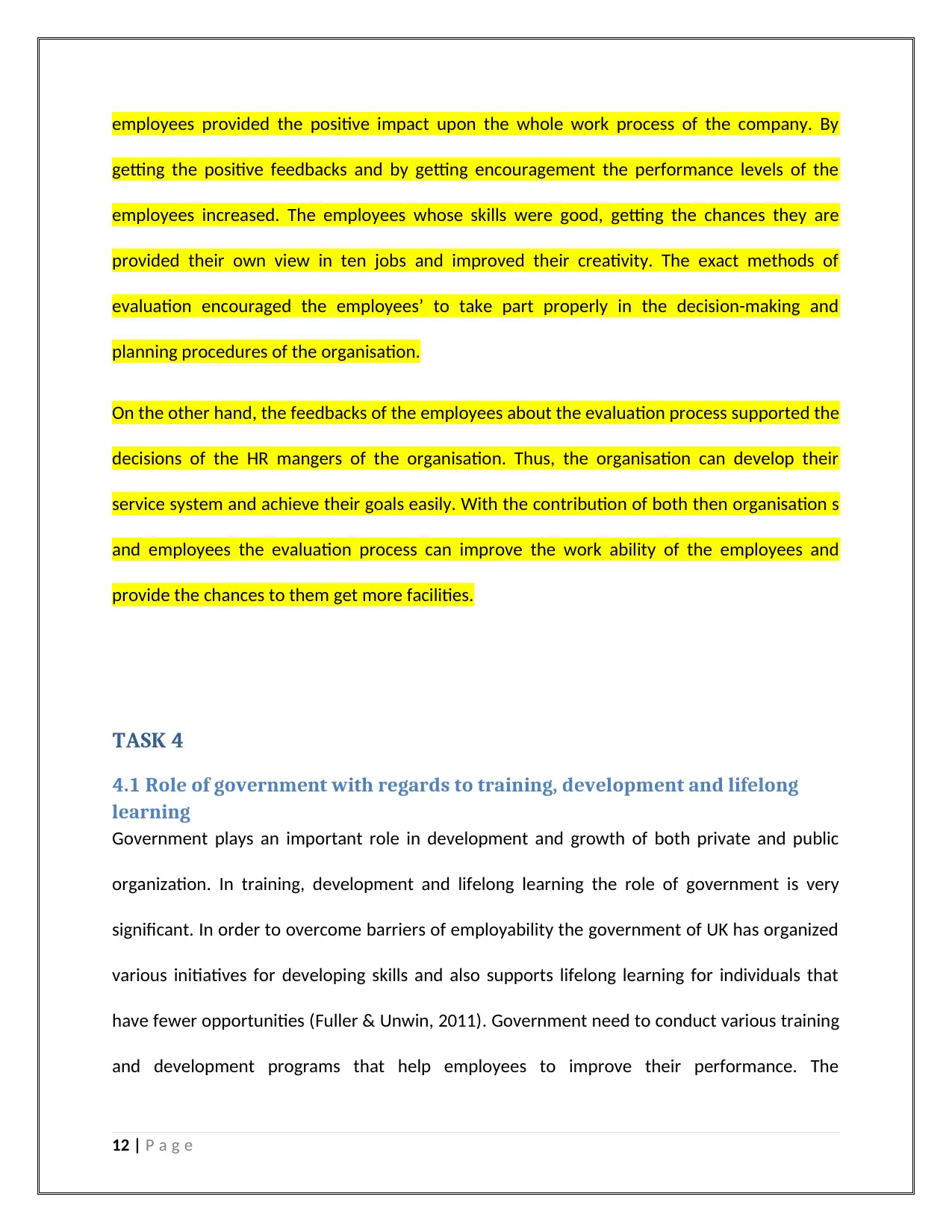
employees provided the positive impact upon the whole work process of the company. By
getting the positive feedbacks and by getting encouragement the performance levels of the
employees increased. The employees whose skills were good, getting the chances they are
provided their own view in ten jobs and improved their creativity. The exact methods of
evaluation encouraged the employees’ to take part properly in the decision-making and
planning procedures of the organisation.
On the other hand, the feedbacks of the employees about the evaluation process supported the
decisions of the HR mangers of the organisation. Thus, the organisation can develop their
service system and achieve their goals easily. With the contribution of both then organisation s
and employees the evaluation process can improve the work ability of the employees and
provide the chances to them get more facilities.
TASK 4
4.1 Role of government with regards to training, development and lifelong
learning
Government plays an important role in development and growth of both private and public
organization. In training, development and lifelong learning the role of government is very
significant. In order to overcome barriers of employability the government of UK has organized
various initiatives for developing skills and also supports lifelong learning for individuals that
have fewer opportunities (Fuller & Unwin, 2011). Government need to conduct various training
and development programs that help employees to improve their performance. The
12 | P a g e
getting the positive feedbacks and by getting encouragement the performance levels of the
employees increased. The employees whose skills were good, getting the chances they are
provided their own view in ten jobs and improved their creativity. The exact methods of
evaluation encouraged the employees’ to take part properly in the decision-making and
planning procedures of the organisation.
On the other hand, the feedbacks of the employees about the evaluation process supported the
decisions of the HR mangers of the organisation. Thus, the organisation can develop their
service system and achieve their goals easily. With the contribution of both then organisation s
and employees the evaluation process can improve the work ability of the employees and
provide the chances to them get more facilities.
TASK 4
4.1 Role of government with regards to training, development and lifelong
learning
Government plays an important role in development and growth of both private and public
organization. In training, development and lifelong learning the role of government is very
significant. In order to overcome barriers of employability the government of UK has organized
various initiatives for developing skills and also supports lifelong learning for individuals that
have fewer opportunities (Fuller & Unwin, 2011). Government need to conduct various training
and development programs that help employees to improve their performance. The
12 | P a g e
⊘ This is a preview!⊘
Do you want full access?
Subscribe today to unlock all pages.

Trusted by 1+ million students worldwide
1 out of 19
Related Documents
Your All-in-One AI-Powered Toolkit for Academic Success.
+13062052269
info@desklib.com
Available 24*7 on WhatsApp / Email
![[object Object]](/_next/static/media/star-bottom.7253800d.svg)
Unlock your academic potential
Copyright © 2020–2025 A2Z Services. All Rights Reserved. Developed and managed by ZUCOL.





